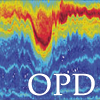
|
Ramsey Harcourt Principal Oceanographer harcourt@uw.edu Phone 206-221-4662 |
Research Interests
Large Eddy Simulation (LES), Computational Fluid Dynamics, Deep Convection, Wave and Ice Boundary Layers, Response of Drifters to Convection
Education
B.S. Physics, Reed College, 1987
M.S. Physics, University of California - Santa Cruz, 1989
Ph.D. Physics, University of California - Santa Cruz, 1999
Projects
|
Wave Measurements at Ocean Weather Station PAPA As part of a larger project to understand the impact of surface waves on the ocean mixed layer, APL-UW is measuring waves at Ocean Weather Station Papa, a long-term observational site at N 50°, W 145°. |
29 Aug 2019
|
|
Intrusions in the North Pacific Subtropical Frontal Zone A field study of the interleaving features in the Subtropical Frontal Zone (STFZ) of the North Pacific Ocean was conducted from in July 2007. The experiment encompassed hydrographic surveying with a towed depth-cycling conductivity-temperature-depth (CTD) platform SWIMS, microstructure profiling, shipboard velocity observations, and |
6 Apr 2011
|
|
Publications |
2000-present and while at APL-UW |
Subsurface acoustic ducts in the Northern California current system Xu, G., R.R. Harcourt, D. Tang, B.T. Hefner, E.I. Thorsos, and J.B. Mickett, "Subsurface acoustic ducts in the Northern California current system," J. Acoust. Soc. Am., 155, 1881-1894, doi:10.1121/10.0024146, 2024. |
More Info |
7 Mar 2024 |
|||||||
|
This study investigates the subsurface sound channel or acoustic duct that appears seasonally along the U.S. Pacific Northwest coast below the surface mixed layer. The duct has a significant impact on sound propagation at mid-frequencies by trapping sound energy and reducing transmission loss within the channel. A survey of the sound-speed profiles obtained from archived mooring and glider observations reveals that the duct is more prevalent in summer to fall than in winter to spring and offshore of the shelf break than over the shelf. The occurrence of the subsurface duct is typically associated with the presence of a strong halocline and a reduced thermocline or temperature inversion. Furthermore, the duct observed over the shelf slope corresponds to a vertically sheared along-slope velocity profile, characterized by equatorward near-surface flow overlaying poleward subsurface flow. Two potential duct formation mechanisms are examined in this study, which are seasonal surface heat exchange and baroclinic advection of distinct water masses. The former mechanism regulates the formation of a downward-refracting sound-speed gradient that caps the duct near the sea surface, while the latter contributes to the formation of an upward-refracting sound-speed gradient that defines the duct's lower boundary. |
|||||||||
High-resolution observations of the North Pacific transition layer from a Lagrangian float Kaminski, A.K., E.A. D'Asaro, A.Y. Shcherbina, and R.R. Harcourt, "High-resolution observations of the North Pacific transition layer from a Lagrangian float," J. Phys. Oceanogr., 51, 3163-3181, doi:10.1175/JPO-D-21-0032.1, 2021. |
More Info |
1 Oct 2021 |
|||||||
|
A crucial region of the ocean surface boundary layer (OSBL) is the strongly-sheared and -stratified transition layer (TL) separating the mixed layer from the upper pycnocline, where a diverse range of waves and instabilities are possible. Previous work suggests that these different waves and instabilities will lead to different OSBL behaviours. Therefore, understanding which physical processes occur is key for modelling the TL. Here we present observations of the TL from a Lagrangian float deployed for 73 days near Ocean Weather Station Papa (50°N, 145°W) during Fall 2018. The float followed the vertical motion of the TL, continuously measuring profiles across it using an ADCP, temperature chain and salinity sensors. The temperature chain made depth/time images of TL structures with a resolution of 6 cm and 3 seconds. These showed the frequent occurrence of very sharp interfaces, dominated by temperature jumps of O(1)°C over 6 cm or less. Temperature inversions were typically small (less than about 10 cm), frequent, and strongly-stratified; very few large overturns were observed. The corresponding velocity profiles varied over larger length scales than the temperature profiles. These structures are consistent with scouring behaviour rather than Kelvin–Helmholtz-type overturning. Their net effect, estimated via a Thorpe-scale analysis, suggests that these frequent small temperature inversions can account for the observed mixed layer deepening and entrainment flux. Corresponding estimates of dissipation, diffusivity, and heat fluxes also agree with previous TL studies, suggesting that the TL dynamics is dominated by these nearly continuous 10-cm scale mixing structures, rather than by less frequent larger overturns. |
|||||||||
Evaluating Monin–Obukhov scaling in the unstable oceanic surface layer Zheng, Z., R.R. Harcourt, and E.A. D'Asaro, "Evaluating Monin–Obukhov scaling in the unstable oceanic surface layer," J. Phys. Oceanogr., 51, 911–930, doi:10.1175/JPO-D-20-0201.1, 2021. |
More Info |
1 Mar 2021 |
|||||||
|
Monin–Obukhov Similarity Theory (MOST) provides important scaling laws for flow properties in the surface layer of the atmosphere and has contributed to most of our understanding of the near-surface turbulence. The prediction of near-surface vertical mixing in most operational ocean models is largely built upon this theory. However, the validity of MOST in the upper ocean is questionable due to the demonstrated importance of surface waves in the region. Here we examine the validity of MOST in the statically unstable oceanic surface layer, using data collected from two open ocean sites with different wave conditions. The observed vertical temperature gradients are found to be about half of those predicted by MOST. We hypothesize this is attributable to either the breaking of surface waves, or Langmuir turbulence generated by the wave-current interaction. Existing turbulence closure models for surface wave breaking and for Langmuir turbulence are simplified to test these two hypotheses. Although both models predict reduced temperature gradients, the simplified Langmuir turbulence model matches observations more closely, when appropriately tuned. |
|||||||||






